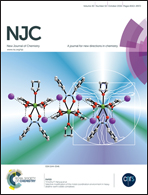Triazole linked ruthenium(ii)–porphyrin: influence of the connectivity pattern on photophysical and electrochemical properties†
Abstract
Herein a copper catalysed click reaction has been used to covalently link π-conjugated 1,2,3-triazolyl zinc(II) porphyrin and ruthenium(II) bipyridyl with a single change in their connection through the linker. The properties of these compounds have been compared with the porphyrin–ruthenium(II) tris(bipyridine) and ruthenium(II) trisbipyridine complexes. Extensive photophysical and electrochemical studies reveal that changes in the electronic properties of the conjugates are a consequence of the different connectivity patterns with regular and inverse triazolyl–pyridyl moieties.


 Please wait while we load your content...
Please wait while we load your content...